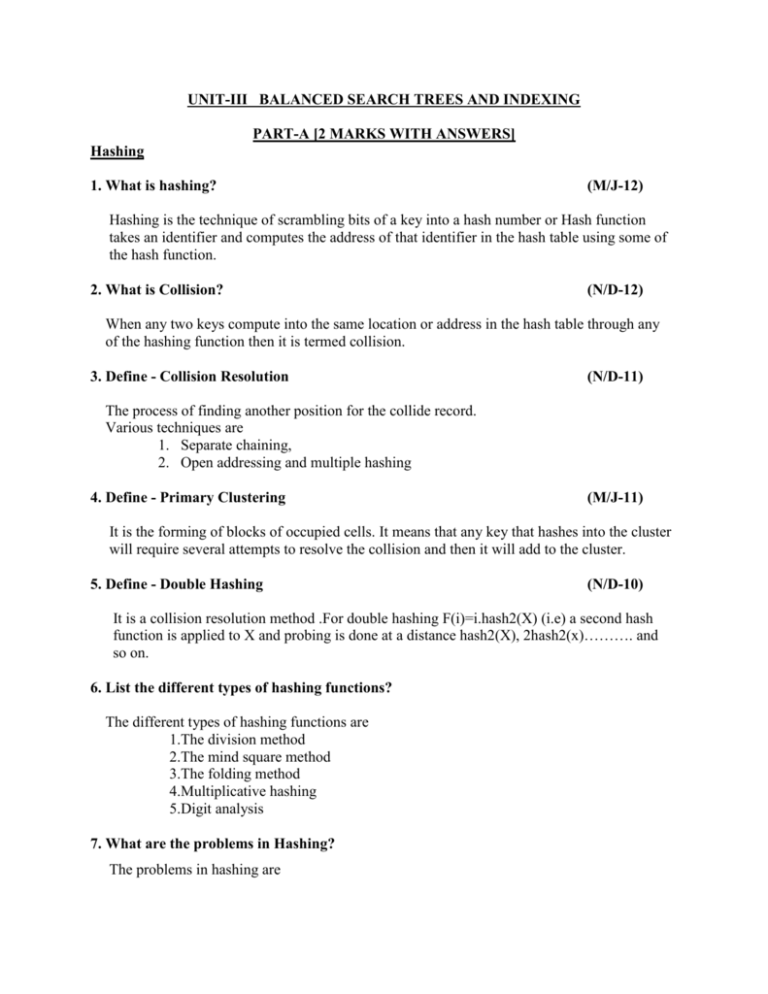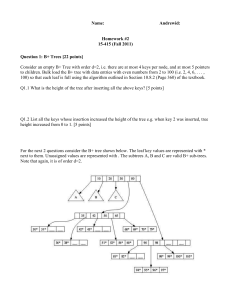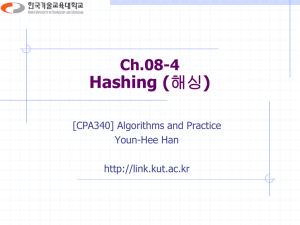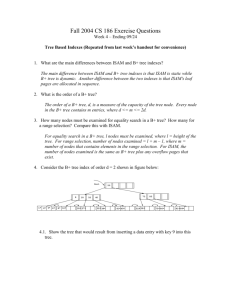Click Here - Ash Harish
advertisement

UNIT-III BALANCED SEARCH TREES AND INDEXING PART-A [2 MARKS WITH ANSWERS] Hashing 1. What is hashing? (M/J-12) Hashing is the technique of scrambling bits of a key into a hash number or Hash function takes an identifier and computes the address of that identifier in the hash table using some of the hash function. 2. What is Collision? (N/D-12) When any two keys compute into the same location or address in the hash table through any of the hashing function then it is termed collision. 3. Define - Collision Resolution (N/D-11) The process of finding another position for the collide record. Various techniques are 1. Separate chaining, 2. Open addressing and multiple hashing 4. Define - Primary Clustering (M/J-11) It is the forming of blocks of occupied cells. It means that any key that hashes into the cluster will require several attempts to resolve the collision and then it will add to the cluster. 5. Define - Double Hashing (N/D-10) It is a collision resolution method .For double hashing F(i)=i.hash2(X) (i.e) a second hash function is applied to X and probing is done at a distance hash2(X), 2hash2(x)………. and so on. 6. List the different types of hashing functions? The different types of hashing functions are 1.The division method 2.The mind square method 3.The folding method 4.Multiplicative hashing 5.Digit analysis 7. What are the problems in Hashing? The problems in hashing are 1.Collision 2.Overflow . 8. What is hash table? A hash table or hash map is a data structure that uses a hash function to map identifying values, known as keys (e.g., a person's name), to their associated values (e.g., their telephone number). 9. What is the use of the hash function? Hash table algorithms calculate an index from the data item's key and use this index to place the data into the array. The implementation of this calculation is the hash function index = f(key, arrayLength) The hash function calculates an index within the array from the data key. arrayLength is the size of the array. 10. What is a perfect hash function? If all keys are known ahead of time, a perfect hash function can be used to create a perfect hash table that has no collisions. If minimal perfect hashing is used, every location in the hash table can be used as well. Perfect hashing allows for constant-time lookups in the worst case. 11. List the applications of hashing Applications of hashing, 1. DBMS. 2. Computer networks 3. Storage of secret data 4. Cryptography. 5. Securing the database 6. Database applications 7. Storing data in a database Rehashing 1. Define - Rehashing (M/J-10) Rehashing is the building of another table with an associated new hash function that is about twice as big as the original table and scanning down the entire original hash table computing the new hash value for each non deleted element and inserting it in the new table. 2. What is the basic requirement to choose a good hash function? (N/D-09) A basic requirement is that the function should provide a uniform distribution of hash values. A non-uniform distribution increases the number of collisions, and the cost of resolving them. Uniformity is sometimes difficult to ensure by design, but may be evaluated empirically using statistical tests, e.g. a Pearson's chi-squared test for discrete uniform distributions. 3. What are the ways in which rehashing can be implemented? 1. Rehash as soon as the table is half full. 2. Rehash only when an insertion fails. 3. Middle of the road strategy is to rehash when the table reaches a certain load factor 4. List the advantages and disadvantages of rehashing Advantage: 1. Table size is not a problem. 2. Hash tables cannot be made arbitrarily large. 3. Rehashing can be used in other data structures. Disadvantage: 1. It is a very expensive operation. 2. The running time is 0(N). 3. Slowing down of rehashing method. Open Addressing 1. What is open addressing? (N/D-08) In open addressing, all entry records are stored in the bucket array itself. When a new entry has to be inserted, the buckets are examined, starting with the hashed-to slot and proceeding in some probe sequence, until an unoccupied slot is found. When searching for an entry, the buckets are scanned in the same sequence, until either the target record is found, or an unused array slot is found, which indicates that there is no such key in the table. 2. Mention the different probe sequences used in open addressing (N/D-08) The well-known probe sequences include: 1. Linear probing, in which the interval between probes is fixed (usually 1) 2. Quadratic probing, in which the interval between probes is increased by adding the successive outputs of a quadratic polynomial to the starting value given by the original hash computation. 3. Double hashing, in which the interval between probes is computed by another hash function. 3. What are the methods of resolving collision in hashing? (N/D-9) The methods to resolving collision in hashing are, 1. Separate chaining hashing. 2. Open addressing hashing. Separate Chaining 1. Define - Sparate Chaining Hashing (M/J-10) Separate chaining means to keep a list of all elements that hash to the same value. 2. What are the advantages of separate chaining? (N/D-10) The advantages of separate chaining are 1. Avoids collision by maintaining linked lists. 2. The link lists will be short if the table is large and the hash function is good. 3. What are the operations of separate chaining? The operations of separate chaining are, 1. Find 2. Insert 4. What are the disadvantages of separate chaining? Disadvantages of separate chaining are 1. Requires pointers. 2. Slows down the algorithm 3. Time is required to allocate new cells. 4. Requires the implementation of a second data structure. Extendible Hashing 1. Define -Extendible Hashing (M/J-11) Extendible hashing allows a find to be performed in two disk access and insertions also require few disk accesses. 2. What is heap order property? (N/D-11) The smallest element should be at the root .Any node should be smaller than all of its descendants.







